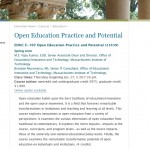Intersection between OEIT and Computational Research
![]() I was asked to provide ideas on how the work we do in OEIT might intersect with computational research. While the first two are not unique, nor even necessarily a great use of computational resources, they do represent untapped areas for applied research that might improve the educational experience at MIT and beyond. The third idea is really Erik Duval‘s idea of examining a campus as a city to understand the interactions that go on, and that we might support via learning spaces and educational technology (in our case). In any event, I provide them here in case anyone’s interested.
I was asked to provide ideas on how the work we do in OEIT might intersect with computational research. While the first two are not unique, nor even necessarily a great use of computational resources, they do represent untapped areas for applied research that might improve the educational experience at MIT and beyond. The third idea is really Erik Duval‘s idea of examining a campus as a city to understand the interactions that go on, and that we might support via learning spaces and educational technology (in our case). In any event, I provide them here in case anyone’s interested.
- Deep Analysis of MIT OpenCourseWare Usage
In its first 10 years there have been an estimated 50 million users of MIT OpenCourseWare. The web usage logs represent a large, relatively untapped, resource for understanding use of this openly available content from around the world. We know from qualitative surveys about the demographics of OCW users, and their self-reported goals and interests in the site. It would be interesting to analyze the quantitative usage logs along a number of dimensions to better understand the impact, the use patterns, and so on. (Colleagues at the Joseph Stephan Institute in Slovenia have expressed interests in this area.)
- Expansive linking of content, curriculum and community via automated methods
There is a deep body of research and knowledge in information retrieval, content summarization, semantic analysis and so on that could be applied to the broad and deep content stores available through MIT OpenCourseWare (and other collections of educational resources) to develop recommender and other systems to extend educational impact. Applying existing research-developed algorithms to the educational challenges and opportunities at MIT might provide valuable insight into MIT interests in content modularity and what that might mean for a 21st century educational experience. (Colleagues at the Joseph Stephan Institute in Slovenia have expressed interests in this area.)
- Examining the city of MIT
There is research interest worldwide in instrumenting and visualizing the built environment through programs such as MIT’s Sensable City Lab. What if we applied these sorts of techniques to instrument MIT’s research, teaching and life experiences on the campus in Cambridge? What might we learn from the interactions and activities to better support Institute goals? (This idea is based on interests described by Erik Duval, but applied to MIT.)



